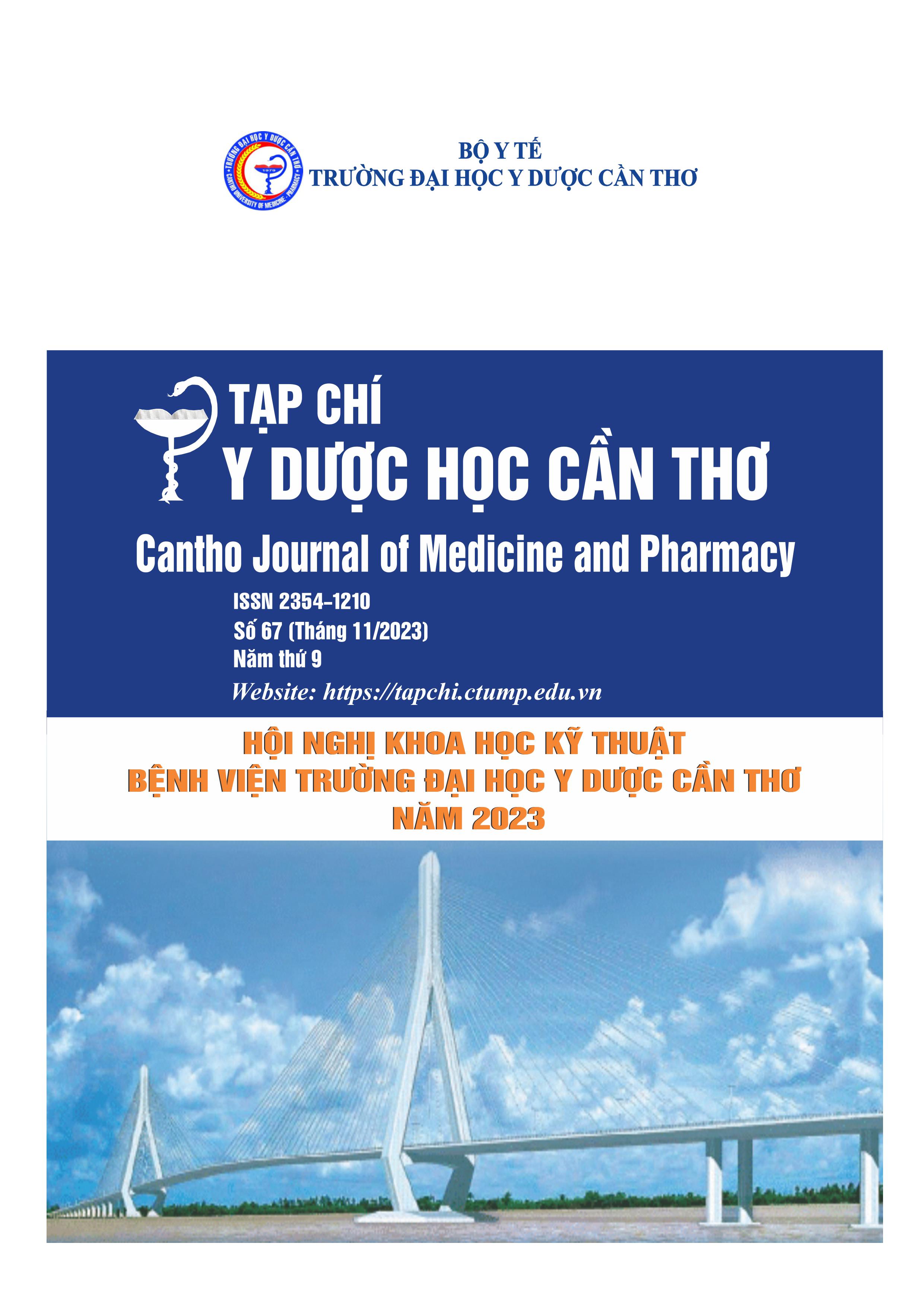THE PREVALENCE OF THE CAGA GENE OF HELICOBACTER PYLORI AND ITS ASSOCIATION WITH GASTRODUODENAL DISEASES
Main Article Content
Abstract
Background: Helicobacter pylori is the leading cause of gastroduodenal diseases. The CagA protein, which is encoded by the cagA gene, is the well-studied toxin of H. pylori. Objectives: (1) To determine the prevalence of the cagA gene of H. pylori isolates from patients with gastroduodenal diseases, (2) to investigate the association between the cagA gene and gastroduodenal diseases. Materials and methods: The study was conducted on 173 positive – H. pylori patients with gastroduodenal disease. H. pylori strains were isolated from gastric mucosa biopsy specimens. The polymerase chain reaction technique was performed to identify the cagA gene. Results: The cagA gene was detected in 83.8% of H. pylori isolates. After adjusting for age and gender, the multivariable logistic regression analysis showed that the H. pylori strain carrying cagA-positive gene was associated with an increased risk for peptic ulcers (aOR = 5.49, 95% CI: 1.06-28.37, p = 0.042). Conclusion: The percentage of H. pylori strains carrying the cagA gene is great. The cagA gene was related to an increased risk for peptic ulcers.
Article Details
Keywords
Helicobacter pylori, cagA gene, gastroduodenal diseases
References
2. T. M. T. Ha, T. N. U. Le, V. N. Nguyen, and V. H. Tran. Association of TP53 gene codon 72 polymorphism with Helicobacter pylori-positive non-cardia gastric cancer in Vietnam. J. Infect. Dev. Ctries. 2019, 13 (11), pp. 984–991, doi: 10.3855/jidc.11488.
3. C.-Y. Kao, B.-S. Sheu, and J.-J. Wu. Helicobacter pylori infection: An overview of bacterial virulence factors and pathogenesis. Biomed. J.. 2016, 39 (1), pp. 14–23, doi: 10.1016/j.bj.2015.06.002.
4. Trần Việt Hùng. Nghiên cứu sự hiện diện các gen cagA, vacA, iceA của Helicobacter pylori ở bệnh nhân ung thư dạ dày và viêm dạ dày mạn. Luận án Tiến Sỹ Y Học, Học Viện Quân Y. 2021, 66-68.
5. S. Sahara et al.. Role of Helicobacter pylori cagA EPIYA motif and vacAgenotypes for the development of gastrointestinal diseases in Southeast Asian countries: a meta-analysis. BMC Infect. Dis..2012, 12 (1), p. 223, doi: 10.1186/1471-2334-12-223.
6. R. M. Peek et al. Detection of Helicobacter pylori gene expression in human gastric mucosa. J. Clin. Microbiol.1995, 33 (1), pp. 28–32, doi: 10.1128/jcm.33.1.28-32.1995.
7. T. N. Phan et al. Genotyping of Helicobacter pylori shows high diversity of strains circulating in central Vietnam. Infect. Genet. Evol. 2017, 52, pp. 19–25, doi: 10.1016/j.meegid.2017.04.014.
8. Nguyễn Thị Mai Ngân. Nghiên cứu kiểu gene cagA, vacA và iceA của Helicobacter pylori ở bệnh nhân bệnh lý dạ dày - tá tràng tại Bệnh Viện Trường Đại Học Y Dược Huế. Luận văn Thạc sĩ Y học, Trường Đại học Y Dược Huế. 2021. 38-45.
9. C. Chomvarin et al. Prevalence of Helicobacter pylori vacA, cagA, cagE, iceA and babA2 genotypes in Thai dyspeptic patients. Int. J. Infect. Dis. 2008, 12 (1), pp. 30–36, doi: 10.1016/j.ijid.2007.03.012.
10. T. Tserentogtokh et al. Western-Type Helicobacter pylori CagA are the Most Frequent Type in Mongolian Patients. Cancers (Basel). 2019, 11 (5), p. 725, doi: 10.3390/cancers11050725.
11. A. Idowu et al. Detection of Helicobacter pylori and its virulence genes (cagA, dupA, and vacA) among patients with gastroduodenal diseases in Chris Hani Baragwanath Academic Hospital, South Africa. BMC Gastroenterol. 2019, 19 (1), p. 73, doi: 10.1186/s12876-019-0986-0.
12. Phạm Hồng Khánh, Trần Thị Huyền Trang, Nguyễn Quang Duật. Tần suất và các yếu tố độc lực của Helicobacter pylori ở bệnh nhân viêm dạ dày mạn. Tạp chí Y Học Việt Nam. 2021, 505. 65-68.
13. P. Correa and J. Houghton. Carcinogenesis of Helicobacter pylori. Gastroenterology. 2007, 133
(2), 659–72, doi: 10.1053/j.gastro.2007.06.026.
14. N. Farzi, A. Yadegar, H. A. Aghdaei, Y. Yamaoka, and M. R. Zali. Genetic diversity and functional analysis of oipA gene in association with other virulence factors among Helicobacter pylori isolates from Iranian patients with different gastric diseases. Infect. Genet. Evol. 2018, 60, 26–34, doi: 10.1016/j.meegid.2018.02.017.


